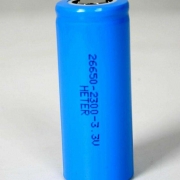Precautions When Using a 26650 Lithium-Ion Battery
There are a few precautions when using a 26650 lithium-ion battery. This type of battery is the largest type and is used in a wide variety of electronic devices. This battery has a nominal voltage of 3.6 or 3.7 volts per cell and can deliver up to 20-30 Amps. The battery’s maximum charge voltage is 4.2 V, so be sure to use a charger that can handle this voltage range.
1. Prevent charging at too low temperature
If the lithium battery is used in a low temperature environment, that is, below 4C, the use time of the 26650 lithium ion battery will also be reduced, and the original lithium battery of some mobile phones cannot even be charged in a low temperature environment. But don’t worry too much, this is only a temporary situation, different from the use in a high temperature environment, once the temperature rises, the molecules in the battery are heated and immediately return to the previous power level.
2. Prevent charging at high temperature
If the 26650 lithium-ion battery is used in an environment higher than the specified operating temperature, that is, above 35C, the battery’s power will continue to decrease, that is, the battery’s power supply time will not be as long as usual. If the device is charged at such a temperature, the damage to the battery will be even greater. Even if the battery is stored in a hot environment, it will inevitably cause corresponding damage to the quality of the battery. Therefore, trying to maintain a suitable operating temperature is a good way to extend the life of lithium batteries.
3. Frequent use
Life is movement. In order to maximize the performance of the 26650 lithium-ion battery, it is necessary to use it frequently so that the electrons in the lithium battery are always in a state of flow. If the lithium battery is not used frequently, please remember to complete a charging cycle for the lithium battery every month and do a power calibration, that is, a deep discharge and deep charge.







